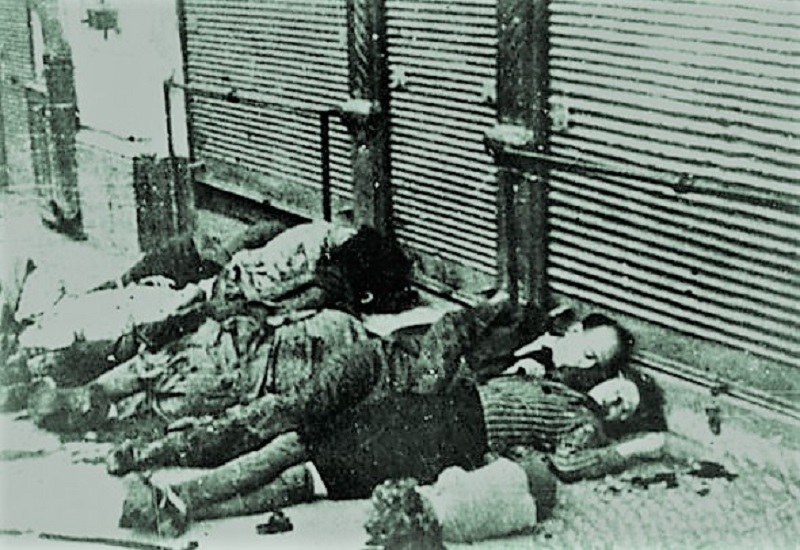
This is a point I have made before, the Holocaust was not perpetrated by Germans alone, there were many more who committed awful crimes. If we only put the blame on the Germans we allow others to get away with it.
During World War II, one of the worst massacres of war took place in Romania. In the country’s second city of Iași. More than 13,000 people, approximately about 10 % of the population, were murdered in the space of a few days, simply because they were Jews. More than 80 years after the Iasi pogrom, most people in Romania know little about these atrocities.
In September 1940, Ion Antonescu rose to power in Romania, and systematic persecution of the Jews began.
On 28 June 1941, Romanian and German soldiers, police, and masses of residents participated in an assault on the Jews of Iasi. Thousands were murdered in their homes and in the streets; additional thousands were arrested and taken to police headquarters. The next day, Romanian soldiers shot thousands of Jews who had been held in the police headquarters yard. The approximately 4,300 survivors of the assault and other Jews who had been rounded up from all parts of Iasi, were loaded onto sealed boxcars and deported. About 2,600 died en route due to thirst and suffocation.
Romania, an ally of the Third Reich, prior to entering the the war, It was commonly but wrongly believed, in Romania, that Communism was the work of the Jews, and Romania’s coming entry into the war against the Soviet Union – a war billed as a struggle to “annihilate” the forces of “Judeo-Bolshevism”- greatly served to increase the anti-Semitic paranoia of the Romanian government.
Prior to the Second World War, the Romanian Jewish community was one of the largest in Europe

Marcel, a Jewish survivor from Iași recounted:
“I remember that the real danger for the Jews started on June 29, 1941. It was a big surprise for all the Jews. We were forced to wear the yellow stars of David on our clothes. We could not buy or sell food anymore. For certain hours, we didn’t have access to some public places. At that time there were cellars where Jews hid. It was difficult for the police to search the cellars. So, in order to make us come to the commissariat, they distributed a sort of ticket with the word “Free” written on it in a Jewish district. The Jews thought that if they showed up at the commissariat they could be set free, could again buy commodities. But it was a trap – instead of receiving freedom, we met death”

A report which was commissioned by, and also accepted by the Romanian government, found that:
“Those participating in the manhunt launched on the night of June 28/29 were, first and foremost, the Iași police, backed by the Bessarabia police and gendarmerie units. Other participants were army soldiers, young people armed by SSI agents, and mobs who robbed and killed, knowing they would not have to account for their actions….In addition to informing on Jews, directing soldiers to Jewish homes and refuges, and even breaking into homes themselves, some Romanian residents of Iaşi also took part in the arrests and humiliation forced upon the convoys of Jews on their way to the Chestura. The perpetrators included neighbors of Jews, known and lesser-known supporters of antisemitic movements, students, poorly-paid, low-level officials, railway workers, craftsmen frustrated by Jewish competition, “white-collar” workers, retirees and military veterans”
At times those who were involved in the crimes, showed some ‘mercy’ by just shooting their victims. An eyewitness later testified:
“Sometimes, those who attempted to defend the Jews were killed with them. This was the case with engineer Naum, a gentile, brother-in-law of Chief Public Prosecutor Casian. Naum, a former Assistant Professor of Medical Chemistry at the Iași Institute of Hygiene, well-known in select circles as an eloquent defender of liberal views, attempted to save a Jew on Pacurari Street, outside the Ferdinand Foundation. The Romanian officer who was about to kill the Jew said to Naum, ‘You dog, die with the kike you are defending!’, and shot him point-blank. The priest Razmerita was shot on Sararie Street while attempting to save several Jews, dying with the victims he was trying to protect. While trying to defend some Jews on Zugravilor Street, outside Rampa, the lathe operator Ioan Gheorghiu was killed by railroad workers”
During the pogrom, the Romanian authorities, together with German soldiers, not only murdered thousands of Jewish residents of Iasi, but also sought to destroy an entire community that had existed for more than 300 years.
The Romanian People’s Tribunals were conducted in 1946 and a total of 57 people were tried for the Iași pogroms: eight from the higher military echelons, the prefect of Iași county and the mayor of Iași, four military figures, 21 civilians and 22 gendarmes. One hundred sixty-five witnesses, mostly survivors of the pogrom, were called to the stand.
sources
http://yahadmap.org/#village/ia-i-yas-jassy-iassy-iassi-ia-i-romania.687
https://www.yadvashem.org/holocaust/this-month/june/1941-3.html

Donation
I am passionate about my site and I know you all like reading my blogs. I have been doing this at no cost and will continue to do so. All I ask is for a voluntary donation of $2, however if you are not in a position to do so I can fully understand, maybe next time then. Thank you. To donate click on the credit/debit card icon of the card you will use. If you want to donate more then $2 just add a higher number in the box left from the PayPal link. Many thanks.
$2.00

Reblogged this on History of Sorts.
LikeLike